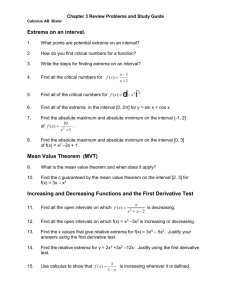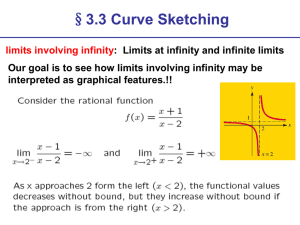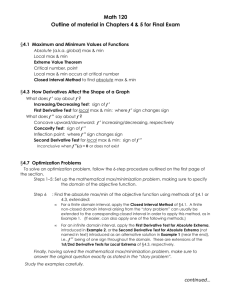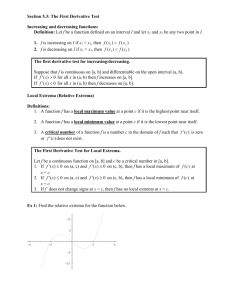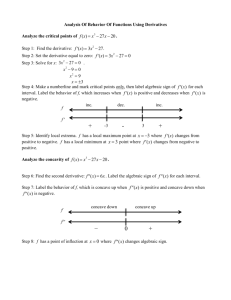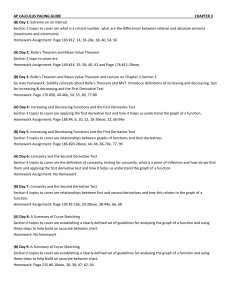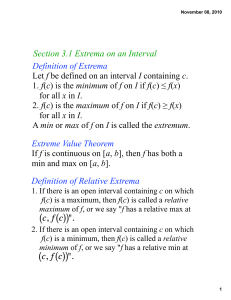Section 3.1: First Derivative Test
advertisement
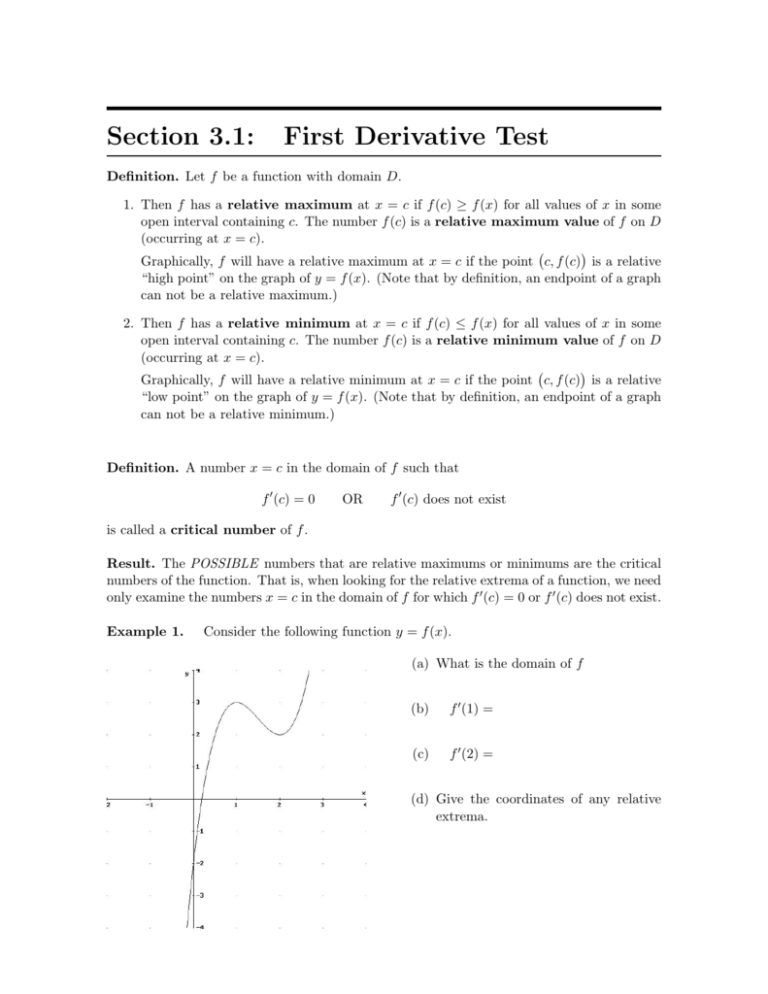
Section 3.1: First Derivative Test Definition. Let f be a function with domain D. 1. Then f has a relative maximum at x = c if f (c) ≥ f (x) for all values of x in some open interval containing c. The number f (c) is a relative maximum value of f on D (occurring at x = c). Graphically, f will have a relative maximum at x = c if the point c, f (c) is a relative “high point” on the graph of y = f (x). (Note that by definition, an endpoint of a graph can not be a relative maximum.) 2. Then f has a relative minimum at x = c if f (c) ≤ f (x) for all values of x in some open interval containing c. The number f (c) is a relative minimum value of f on D (occurring at x = c). Graphically, f will have a relative minimum at x = c if the point c, f (c) is a relative “low point” on the graph of y = f (x). (Note that by definition, an endpoint of a graph can not be a relative minimum.) Definition. A number x = c in the domain of f such that f 0 (c) = 0 OR f 0 (c) does not exist is called a critical number of f . Result. The POSSIBLE numbers that are relative maximums or minimums are the critical numbers of the function. That is, when looking for the relative extrema of a function, we need only examine the numbers x = c in the domain of f for which f 0 (c) = 0 or f 0 (c) does not exist. Example 1. Consider the following function y = f (x). (a) What is the domain of f (b) f 0 (1) = (c) f 0 (2) = (d) Give the coordinates of any relative extrema. 2 SECTION 3.1: FIRST DERIVATIVE TEST Definition. A function f is increasing % on an interval I if f (a) < f (b) for each pair of numbers a and b in I with a < b. The function is decreasing & on an interval I if f (a) > f (b) for each pair of numbers a and b in I with a < b. Results: • If f 0 (x) > 0 on an interval, then f is increasing % on that interval. • If f 0 (x) < 0 on an interval, then f is decreasing & on that interval. The First Derivative Test. Suppose that x = c is a critical number of a continuous function f . • If f 0 (x) changes sign from positive to negative at x = c, then f has a relative maximum at x = c. • If f 0 (x) changes sign from negative to positive at x = c, then f has a relative minimum at x = c. • If f 0 (x) does not change sign from positive to negative (or vice versa) at x = c, then f has neither a relative maximum nor a relative minimum at x = c. How to find relative extrema using the First Derivative Test. 1. Find the numbers x = c in the domain of f where f 0 (c) = 0 or f 0 (c) does not exist. (That is, find the critical numbers of f .) 2. Plot these critical numbers on a number line. 3. Determine the sign of f 0 (x) both to the left and right of these critical numbers by evaluating f 0 (x) Keep in mind that if f 0 (x) > 0, then at test numbers. the function is 0 increasing % , and if f (x) < 0, then the function is decreasing & . 4. (a) If f 0 (x) changes from + to − at x = c i.e., % to & , then f has a relative maximum at x = c. (b) If f 0 (x) changes from − to + at x = c i.e., & to % , then f has a relative minimum at x = c. (c) If f 0 (x) does not change sign at x = c i.e., & to & OR % to % , then f has neither a relative maximum nor a relative minimum at x = c. SECTION 3.1: FIRST DERIVATIVE TEST 3 Example 2. Use the First Derivative Test to find the relative extrema of f (x) = 13 x3 + 21 x2 − 12x + 1. Give only the x-coordinate(s) of the extrema. Solution. First find the critical numbers: f 0 (x) = x2 + x − 12. So the critical numbers are x2 + x − 12 = 0 (x + 4)(x − 3) = 0 x−3=0 x+4=0 x = −4 x=3 Plot these critical numbers on a number line. Notice how the number line is divided into three regions: I , II , and III . I II III −4 3 We now need to determine if the function is increasing or decreasing on each of these regions. To do this, we evaluate the derivative at test numbers chosen from each region. (In this case, we will choose −5, 0, and 4 as our test numbers.) Remember that if the first derivative is positive, then the function is increasing % , and if it is negative, then the function is de creasing & . −→ % & −5 −4 0 −→ 3 % 4 f 0 (−5) = (−5)2 + (−5) − 12 f 0 (0) = (0)2 + (0) − 12 f 0 (4) = (4)2 + (4) − 12 f 0 (−5) = +8 f 0 (0) = −12 f 0 (4) = +8 + − + From the sign chart, we see that f has a relative maximum at x = −4 and a relative minimum at x = 3. Note that if the problem asked for the y-coordinates of the extrema (that is, the relative maximum and minimum values), then we would simply find f (−4) and f (3). 4 Example 3. SECTION 3.1: FIRST DERIVATIVE TEST Use the First Derivative Test to find the relative extrema of f (x) = f (x) = 3x4 − 4x3 − 36x2 − 5. x2 . (NOTE: Be sure to pay close x−3 attention to the function’s domain and any vertical asymptotes.) Example 4. Find the relative extrema of f (x) = SECTION 3.1: FIRST DERIVATIVE TEST 5 EXERCISES Use the 1st Derivative Test to find the relative extrema of the following functions. Give only the x-coordinates of the extrema. Indicate your answer as a relative max or min. Pay close attention to the function’s domain and any vertical asymptotes. 1. f (x) = x3 − 3x2 − 24x + 2 2. f (x) = 2x3 + 3x2 − 36x + 5 3. f (x) = x3 − 12x + 5 4. 5. 14. f (x) = 5x (x + 3)3 15. f (x) = x2 (x − 4)3 16. f (x) = x2 x2 + 1 (Note: Domain = R.) f (x) = 3x4 − 4x3 − 36x2 − 5 f (x) = x4 − 4x3 +3 17. f (x) = x2 x +9 (Note: Domain = R.) 6. f (x) = 6x5 − 40x3 + 1 18. 7. f (x) = f (x) = x4 − 6x2 + 5 ex +1 x2 (Note: Domain = R.) 8. 9. 10. f (x) = x3 − 6x2 + 3x + 1 19. √ f (x) = 4x x + 6 20. √ f (x) = (2x − 4) x + 4 21. f (x) = f (x) = 3x4 + 8x3 − 5 f (x) = (2x + 6)4 f (x) = 12. x2 + 4 f (x) = 2 x −4 13. f (x) = 5x2 (x − 2)2 x2 + 1 (Note: Domain = R.) x2 x−3 11. √ 22. f (x) = ln(x2 + 1) (Note: Domain = R.) 23. f (x) = x2 ex 6 SECTION 3.1: FIRST DERIVATIVE TEST ANSWERS 1. Relative max at x = −2 Relative min at x = 4 2. Relative max at x = −3 Relative min at x = 2 3. Relative max at x = −2 Relative min at x = 2 4. Relative max at x = 0 Relative min at x = −2, 3 13. Vertical asymptote at x = 2 Relative min at x = 0 14. Vertical asymptote at x = −3 Relative max at x = 3/2 15. Vertical asymptote at x = 4 Relative max at x = 0 Relative min at x = −8 16. Relative min at x = 0 5. Relative min at x = 3 6. Relative max at x = −2 Relative min at x = 2 17. Relative max at x = 3 Relative min at x = −3 7. Relative max at x = 0 √ √ Relative min at x = − 3, 3 18. No Relative max or min √ 8. Relative max at x = 2 −√ 3 Relative min at x = 2 + 3 19. Domain is x ≥ −6 Relative min at x = −4 9. Relative min at x = −2 20. Domain is x ≥ −4 Relative min at x = −2 10. Relative min at x = −3 21. Relative min at x = 0 11. Vertical asymptote at x = 3 Relative max at x = 0 Relative min at x = 6 12. Vertical asymptotes at x = ±2 Relative max at x = 0 22. Relative min at x = 0 23. Relative max at x = −2 Relative min at x = 0

